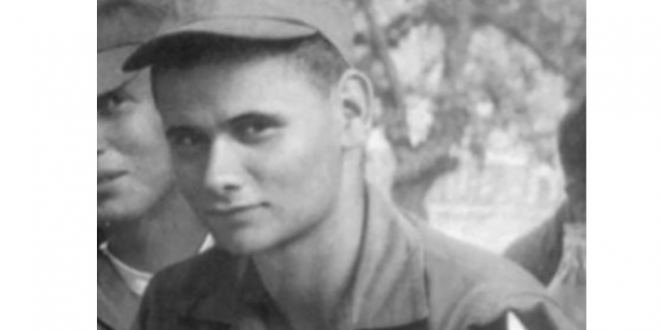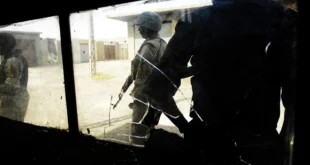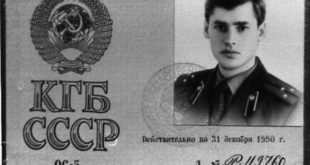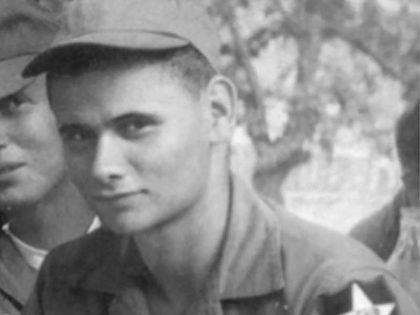
Bob,
Remember the article I wrote a while back in SOF about Dwight Birdwell and his actions as a tank commander during the relief of Tans Nhut AB during TeT of ’68 wherein he was put in for the MOH by his commanding officer, then Lt Colonel Otis, but the recommendation was changed (downgraded) by a couple of clerks in HQ that didn’t like him to the Silver Star?
Otis retired as a four star general, and when he found out that Dwight only got the SS he re-submitted him for the MOH. You and I know that once you’re retired few that are still AcDu give us much credence, so Otis’s recommendation stalled at Ft. Knox on a female major’s desk and that’s where it stopped for a very long time. Birdwell’s former Troop leader, Lt. Jerry Headley managed to push it out of Ft. Knox eventually and get it to DoD.
And there it sat. Until Inhofe pushed it through last week.
Myself and a couple of other vets have been fighting an up hill battle with the Army, DoD, the Pentagon and other REMFs. We finally were able to get someone I know who. retired CWO George Headrick (also a Vietnam vet), who has good relations with Sen. Inhofe’s staff and Inhofe himself to look over the documentation we had, the requests and denials and other records.
We learned yesterday that Dwight HAS been approved as one of four veterans who will receive it sometime before January 5th (if nothing interferes on the national level before then).
One of the pieces of information that went to Sen. Inhofe and is staff in Tulsa and in Washington was a copy of the article from SOF. It was kind of an executive summery of the action and made it easy for those in the chain to understand what happened that day and that he rated more than the SS!
Just wanted to let you know.
Best,
Craig Roberts
3-4 Cavalry, Blasting Away During the Set Offensive
By LTC Craig Roberts, USAR, Ret.
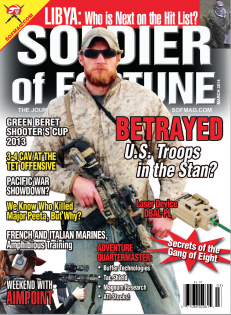
In the early morning hours of January 31st, 1968, Communist forces across South Vietnam began an offensive that would later become known as the “Tet Offensive.” For months the attacks against American and South Vietnamese bases had been planned and organized. The North Vietnamese generals, led by Minister of Defense Vo Nguyen Giap, had planned the attack to coincide with Vietnam’s Lunar New Year, a holiday season where many of the South Vietnamese troops would be home on leave, or at least not on duty at their various bases.
The plan was bold. For the Saigon attacks Giap formulated a coordinated attack with missions to seize and neutralize key command and control centers, armor and artillery depots at Go Vap, take over the Cholon sector of Saigon, neutralize Tan Son Nhut Air Base in Saigon, and at the same time destroy the Newport Bridge that linked Saigon to Long Bin-Bien Hoa on Highway One. Further, VC and NVA forces were ordered to seize the logistic center at Long
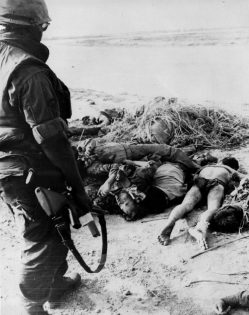
Bien, take out the US air base at Bien Hoa–and block any attempts by the US 1st Infantry Division to provide relief from Lai Khe, and the 25th Infantry Division from doing the same from Cu Chi along Highway One.
At his command for the Saigon attacks Giap had 35 battalions of regular and guerrilla forces. He divided them into one NVA division and two VC divisions. The stage was set, and on the evening of the 30th, a large VC force infiltrated the Vinatexco Textile Factory on Highway One, just across from Tan Son Nhut. Then after 3 a.m. the next morning three VC battalions from the 271st VC Regiment stormed the western end of the Air Base, managed to penetrate the fortifications and were soon on the runway. Hundreds of other VC/NVA lay in wait, nearby, to challenge any relief efforts, for the base.
Air Force Security Police held on, supported by two companies of the ARVN 8th Airborne Battalion who were inside the terminal waiting for air transport to reinforce the DMZ. Any help would have to come from outside Saigon.
The calls for help were heard at the headquarters of the 25th Infantry Division at Cu Chi, about 25 miles northwest of Saigon. Armor was needed, and it would be a race against the clock to get to the airbase before it fell.
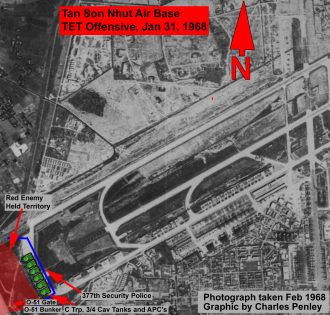
Troop C, 3rd Squadron, 4th Cavalry, equipped with M-48 tanks and M113 armored personnel carriers, mounted up, and after engaging in some evasive techniques, finally hit Highway One. Little did the troopers know the size of the enemy force Giap had assembled, which they would face once they arrived at the Air Base. The C Troop force totaled approximately 100 men, perhaps less. Specialist Dwight W. Birdwell, an M-48 tank gunner, was on one of the lead vehicles to hit the road.
Birdwell, a Cherokee Indian from Oklahoma, joined the Army when other youths of his age were doing everything they could to avoid the draft. Warrior blood ran through his veins, and he volunteered for tanks, and for Vietnam. Unfortunately, when he arrived in Vietnam, he was selected by a sergeant at Troop headquarters to be a radio repairman. This is not what he volunteered for, and he told the sergeant that he was a tanker, and wanted to go to the field with the Troop. The sergeant insisted that he be trained to repair radios, and that he was better off in the rear.
In Birdwell’s words, “The truck ferrying replacements to their units dropped me off outside the orderly room, a sandbagged tent with a wooden floor. Inside, the first sergeant made no effort to welcome me to the unit. The best he could muster was a grimace at my bandaged foot that I had hurt while on leave just before flying to Vietnam, as if I was probably a malingerer. I was on crutches, but it was only temporary. The two clerk-typists in the tent were equally cold in their attitude. The first shirt assigned me to a Staff Sergeant commo NCO in Headquarters platoon “‘til you get healed up”, he said.

I spent the first month in Vietnam working on radios. But once I got back on my feet I made every effort to get assigned to a field unit. As luck would have it, I did manage to break out of the commo section by talking to one of the Third Platoon Staff Sergeants who wrangled a transfer–which really pissed off the commo sergeant. As a result of making the commo sergeant angry, his close friend, the First Sergeant of C Troop, insisted that Birdwell be assigned to and serve with the Third Platoon Infantry Squad. Birdwell soon became an Infantry Team Leader, and served in that role for several months before being transferred to a M-48 A3 tank in mid-January, 1968.
When the Tet Offensive started, and the order came to saddle up and head out for Tan Son Nhut, Birdwell was a gunner and his tank was just behind the lead platoon in the column that raced down Highway One toward Saigon. While the tanks and tracks rumbled down the road, the squadron commander, LTC Glenn K. Otis, flew overhead in his UH-1 command-and-control helicopter. Otis could see potential ambush areas all along the route, and by dropping flares, he guided his troops around and away from ambush sites and kill zones. The night before, Otis had ordered the First Platoon of C Troop to secure the Hoc Mon Bridge north of the base. Once the Second and Third Platoons were a short distance away from Tan Son Nhut, Otis returned to Cu Chi Base Camp to re-arm and re-fuel. No sooner than Otis had landed, the Second and Third Platoons ran into the middle of an estimated VC/NVA force of 2,500 personnel.
The Second Platoon, leading the advance, began taking devastating fire immediately. The column could not maneuver off the road because the perimeter fence of the Air Base was on one side, and a village full of NVA was on the other side. They were caught in a crossfire from the front, as well as their left and right sides. Within a few moments, the Second Platoon was almost destroyed. Upon being informed of what was happening, LTC Otis immediately boarded another helicopter, and headed for the base.
Birdwell’s tank commander was hit almost immediately, knocking him away from the exposed .50 caliber machine gun on top of the turret, down into the tank. Birdwell checked his wounds: one eye was shot out, leaving a serious head wound. Birdwell dragged him out of the turret to the side of the tank, where he passed his body to others for treatment. Birdwell then took his place in the commander’s cupola, put on the CVC helmet, plugged in the commo line, and began firing both the main gun and the .50 caliber M21.
“As focused as I was,” related Birdwell in his book A Hundred Miles of Bad Road, “I didn’t realize the point platoon had been utterly destroyed in the initial ambush. Captain Virant, our Troop Commander, had been hit by metal fragmentation in the back of his head, fracturing his skull. He was lying unconscious in the command APC. His artillery lieutenant had lost several fingers and had a massive gunshot wound in his thigh, the driver was dead, as was the track commander.” Effectively, the only leadership on the ground remained within the NCO’s and Troopers were fighting for their lives. LTC Otis placed SSG Gary Brewer of the Third Platoon, in charge of the C Troop remnant. Brewer, a well-seasoned soldier, was awarded the Distinguished Service Cross for his heroic acts that day.
The column had lost several vehicles. Many were on fire, and their ammo was cooking off. Birdwell’s tank, C-35, was now the lead vehicle capable of returning fire.
“All I knew in the heat of the moment was that the .50 Cal MG on my tank had no armor shield. You made yourself an outstanding target when you put it into action, and as I pumped away, sitting on the opened cupola hatch cover, there was a constant and terrifying buzz from rounds whizzing past or ricocheting off the turret. Several RPGs seemed to fly right at me, but at the last moment one overshot the tank and the others sailed past to the left to explode on the air base.”
Birdwell could see that all the vehicles to his front were out of action. When the NVA began climbing over them, attempting to turn their machine guns around, Birdwell hosed them with his .50. “Every vehicle ahead of us had been put out of action. I could see the few survivors trying to get back to my position. I kept up a tremendous amount of fire to cover them. Our ten foot tall, twelve foot wide tank covered the APCs behind me against most frontal fire, and our superior firepower over the lesser number of guerrillas to our right flank kept them at bay.”
The troopers braced up and fought it out. Lieutenant Colonel Otis took control of the situation and brought in gunships and resupply ships. The enemy had entrenched .51 caliber machine guns and played havoc with the choppers. Otis was shot down four times that day and wounded, but continued to get into another Huey and carry on. For his heroic acts and leadership, Otis was awarded the Distinguished Service Cross.
While all this was happening, the tank at the rear of the column began breaching the air base perimeter fence, running over the wire several times to make a path for the remaining tanks and tracks to get inside the air base to complete the link-up with the besieged force.
Meanwhile, Birdwell fired round after round from the main 90mm gun to the point where it was so hot that when a round failed to fire, he feared it would cook off. Without thinking he opened the breach, pulled out the round with his bare hands, and threw it outside the tank. His hands were now scorched, but he returned to the machine gun and resumed firing.
“The gunships kept roaring down our right flank, and Hueys kept landing nearby to unload ammunition for us no matter how many were shot down in the process.
Reinforcements were on the way, but Birdwell and the infantrymen from the M113 armored personnel carriers behind him had to hold out. Birdwell concentrated the main gun fire on a distant tree line, pulling on the firing lanyard from his position atop the cupola behind the .50 while his loader slammed round after round into the breach, locking it and shouting “UP!”
“We fired HE, WP and even HEAT (High Explosive Anti-Tank), and canister and bee-hive. I pulled ammo can after ammo can off the bustle rack behind the turret for the .50. Incoming fire was intense and at one point the loader yelled at the driver to “back up or we’ll all get killed!” I tried to countermand that order but got no reaction. I didn’t realize it but a part of my commo apparatus had been shot off my helmet! I looked behind us and saw several wounded soldiers shrieking at us to stop before we ran over them. I jumped out of the tank as the engine roared, ran around to the front and beat on the driver’s hatch until he opened up. I ordered him back to our original position immediately and he complied.”
At one point Birdwell lost the use of the .50. The barrel was burned out. Instead of pulling back, he grabbed his M-16. “We had just received the new improved version with the chrome chamber which was less likely to jam as did the earlier versions. I squeezed off the magazine in one burst. Two or three VC went down in my sights and did not get back up. The rest slipped through the wire down where the lead vehicles were sitting and escaped across the highway into the enemy hamlet.”
Meanwhile the situation inside the Air Base began to stabilize. The First Platoon had rushed in from their holding position at Hoc Mon Bridge, turned into the service road north of the textile mill, and entered the base through a small gate on the perimeter fence. They managed to link up with the besieged Air Force Security Police.
But the battle on the road was not over. “I fired the balance of our main gun ammunition. The tank carried sixty-four 90mm rounds, and except for two duds, we sent all of them into the enemy positions. I also went through all our .50 ammo and was reduced to popping away with my M16 from the top of the turret. It didn’t take long to use up all my magazines.”
Then fate intervened. LTC Otis’s command Huey was shot down and made a hard landing near Birdwell’s tank. Another chopper landed and picked up Otis, along with his artillery officer, and sped off to resume the fight. Birdwell was out of ammo, but the Huey had two M-60 machine guns still on board. Birdwell grabbed both, salvaged some ammo, and returned to C-35. He gave one of the guns to a soldier in the APC behind him, and then resumed firing from the turret with the other until something exploded that took the end off the barrel, sending shrapnel into his face and chest.
Now reduced to only a .45 pistol, Birdwell finally abandoned C-35 and took cover with a group of the infantrymen in the roadside ditch. But still they held out and refused to fall back.
Just when Birdwell thought he’d fight with his seven rounds of .45 ammo, then fists, the cavalry arrived! Troop B came to the rescue after racing down thirty nine kilometers from its security position at Trang Bang Bridge to Tan Son Nhut. Bravo Troopers, mounted and dismounted, fought through the village, killing the enemy in spider holes and other positions. The NVA and VC ambush was now a killing field, but not the way they had planned it. The battle for Tan Son Nhut was finally over.
At the insistence of LTC Otis, Dwight W. Birdwell was put in for the Medal of Honor. But when the paperwork made its way through the Smith Corona Commandos in the C Troop Orderly Room, who disliked Birdwell, what emerged was poorly written, and omitted most of the heroic acts performed by Birdwell. Complicating the situation was the fact that Otis was severely wounded in May, 1968, medically evacuated for treatment, and never returned. As a consequence of poor drafting, the omission of numerous heroic acts and absence of LTC Otis to oversee the Medal of Honor effort, the recommendation was downgraded to the Silver Star. “For me there was no ceremony. I was simply called to the troop orderly room one day six months later and a clerk handed me the medal in its case, along with a blue folder which contained copies of the citation.”
What is amazing is to take Birdwell’s action, described above, then compare it with the action in WWII of Second Lt. Audie Murphy, and both are almost identical, except Birdwell actually did much more, using more weapons, over a longer period of time, against a far superior force. Murphy was awarded the Congressional Medal of Honor, Dwight W. Birdwell received the Silver Star–all due to personality conflicts, omissions and incompetent drafting.
In an effort to correct this, Birdwell’s old commanding officer, LTC Glenn K. Otis–who retired as a four star general and as commander of US Army, Europe–has submitted an upgrade request on behalf of Birdwell for the Medal of Honor. Still, the Army remains indifferent to the request, asking for more and more material.
Part of the “Justification for the Award of the Medal of Honor” written by General Otis states: “for his actions on January 31, 1968, Dwight Birdwell was awarded a Silver Star. However, many of the people who participated in the battle, including the Commander of 3rd Squadron, 4th Cavalry (General Otis) on that date believe that the Silver Star citation does not adequately reflect the supreme gallantry, far above and beyond the call of duty displayed by Dwight Birdwell on that day. With complete disregard for his own life, Dwight was seen to single-handedly drive off multiple attacks, from multiple directions, using multiple weapons. While doing this, Dwight Birdwell was one of only two people providing radio reports to the cavalry squadron’s commanding officer, allowing him to direct deployment of reinforcements. When wounded, Dwight Birdwell refused to quit the battle. More than one person present on that day has stated that if not for the extraordinary bravery of Dwight Birdwell, Troop C and perhaps Tan Son Nhut airbase itself might very well have been overrun before additional forces could arrive to assist.”
The latest news is that the Army has asked for multiple documents, more paperwork, including records that no longer exist, providing more witness statements, and otherwise, serving up a new version of Catch 22. Their latest statement? Paraphrasing: “The Silver Star Citation has the same information as the request for the MOH, so other evidence is needed.”
Really? Those working on Dwight’s behalf have produced notarized witness statements, all from former soldiers who were there. General Otis’s recommendation alone should have been enough.
But how do you fight against a handful of clerks who just didn’t like you back in the day, coupled with the current Army mindset?
What is fair, is fair. Dwight W. Birdwell is an American hero, and should be recognized as such.
Dwight Birdwell returned from Vietnam, put himself through college and law school and is now a practicing attorney doing work in the oil and gas industry in Oklahoma. He is also a former Chief Justice of the Cherokee Supreme Court.
LTC Craig Roberts is a US Marine Vietnam Veteran, having served in the 9th Marine Regiment in I Corps in 1965-66. He served 30 years, active and reserve, in the US Marine Corps and US Army Reserve. He is the author of several books including “One Shot-One Kill” and “Crosshairs on the Kill Zone”, both about American combat snipers. His website is www.riflewarrior.com
 Soldier of Fortune Magazine The Journal of Professional Adventurers
Soldier of Fortune Magazine The Journal of Professional Adventurers


